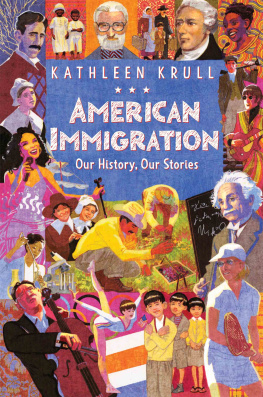Contents
Guide
Australia
HarperCollins Publishers Australia Pty. Ltd.
Level 13, 201 Elizabeth Street
Sydney, NSW 2000, Australia
www.harpercollins.com.au
Canada
HarperCollins Publishers Ltd
Bay Adelaide Centre, East Tower
22 Adelaide Street West, 41st Floor
Toronto, Ontario, M5H 4E3
www.harpercollins.ca
India
HarperCollins India
A 75, Sector 57
Noida
Uttar Pradesh 201 301
www.harpercollins.co.in
New Zealand
HarperCollins Publishers New Zealand
Unit D1, 63 Apollo Drive
Rosedale 0632
Auckland, New Zealand
www.harpercollins.co.nz
United Kingdom
HarperCollins Publishers Ltd.
1 London Bridge Street
London SE1 9GF, UK
www.harpercollins.co.uk
United States
HarperCollins Publishers Inc.
195 Broadway
New York, NY 10007
www.harpercollins.com
ROGER DANIELS is Charles Phelps Taft Professor of History Emeritus at the University of Cincinnati. He received his Ph.D. from UCLA in 1961 and is a past president of both the Immigration and Ethnic History Society and the Society for Historians of the Gilded Age and the Progressive Era. He has written widely about Asian Americans and immigration. Among his most recent books are Not Like Us: Immigrants and Minorities in America, 18901924; Debating American Immigration, 1882Present (with Otis Graham); and American Immigration: A Student Companion.
Discover great authors, exclusive offers, and more at hc.com.

This book was written during a years sojourn in Germany where I was a Visiting and Fulbright professor at the University of Hamburg. I like to think that residence in one of the greatest ports of emigration and visits to Bremen, Genoa, Liverpool, and London somehow enriched this work. My greatest debts are to my fellow students of immigration and ethnicity, whose work I have quoted and paraphrased throughout. They are acknowledged in the traditional way in the text, notes, and bibliography. My colleagues and friends at the University of Hamburg gave me a light teaching load and provided an atmosphere in which I could write. My sponsor, Professor Dr. Gnter Moltmann, a specialist in German emigration and perhaps the Federal Republics leading Americanist, was unfailingly generous of his time and resources. The director of the Historisches Seminar that year, Professor Dr. Horst Pietschmann, went out of his way to make me feel welcome, and Dr. Hans-Jrgen Grabbe was an unfailing source of good advice on all things German, from high culture to haircuts. Dr. Andreas Brinck, then in the final stages of writing his Ph.D. thesis, helped me cope with the bewildering array of separate libraries in Hamburg. Frau Renate Daumann provided secretarial and logistical support and much more, including expanding my German vocabulary with such terms as gummibands and super! In addition, the students in my Hamburg seminars often gave me very different European perspectives on immigration matters, as did students in other European universities I visited. In the United States, my editor, Paula McGuire of Visual Education Corporation, emended the text with skill, unfailing good sense, and enthusiasm; and Cynthia Cappa, Picture Research Coordinator, fulfilled the picture specifications with imagination and perseverance. Susan H. Llewellyn, the copyeditor at HarperCollins, contributed substantially to the coherence and clarity of the book. My graduate student and assistant in Cincinnati, Kriste Lindenmeyer, performed a wide range of chores cheerfully and with great discretion. My colleague John K. Alexander saved me from a grievous error.
The picture research was greatly assisted by cooperation and courtesy from Phyllis Montgomery of the Metaform consortium in New York, Barry Moreno of the Ellis Island Archives of the National Park Service, Joachim Frank of the Hamburg Staatsarchiv, and Astrid Knopke.
I must also acknowledge the financial assistance of the American and German Fulbright commissions, which helped support my stay in Germany, and those of Britain, France, Italy, and Austria, which financed travels in those countries. Important support was provided by the University of Cincinnati, which gave me leave and funded some of my year abroad. I particularly wish to thank Dean Joseph Caruso and my chair, Otis C. Mitchell. Last but not at all least, I thank my fellow traveler, Judith M. Daniels, who was constantly interrupted in her own work in American Jewish history to listen, suggest, and counsel, and who put up with, almost without complaint, the various noises of literary creation in very close quarters.
INS Summary of IRCA (1986) and Immigration Act of 1990
I MMIGRATION R EFORM AND C ONTROL A CT OF N OVEMBER 6, 1986 (IRCA)
(100 Statutes-at-Large 3359)
Comprehensive immigration legislation:
A. INS Summary of IRCA (1986) and Immigration Act of 1990Authorized legalization (i.e., temporary and then permanent resident status) for aliens who had resided in the United States in an unlawful status since January 1, 1982 (entering illegally or as temporary visitors with authorized stay expiring before that date or with the Governments knowledge of their unlawful status before that date) and are not excludable.
B. Created sanctions prohibiting employers from knowingly hiring, recruiting, or referring for a fee aliens not authorized to work in the United States.
C. Increased enforcement at U.S. borders.
D. Created a new classification of seasonal agricultural worker and provisions for the legalization of certain such workers.
E. Extended the registry date (i.e., the date from which an alien has resided illegally and continuously in the United States and thus qualifies for adjustment to permanent resident status) from June 30, 1948, to January 1, 1972.
F. Authorized adjustment to permanent resident status for Cubans and Haitians who entered the United States without inspection and had continuously resided in country since January 1, 1982.
G. Increased the numerical limitation for immigrants admitted under the preference system for dependent areas from 600 to 5,000 beginning in fiscal year 1988.
H. Created a new special immigrant category for certain retired employees of international organizations and their families and a new nonimmigrant status for parents and children of such immigrants.
I. Created a nonimmigrant Visa Waiver Pilot program allowing certain aliens to visit the United States without applying for a nonimmigrant visa.
J. Allocated 5,000 nonpreference visas in each of fiscal years 1987 and 1988 for aliens born in countries from which immigration was adversely affected by the 1965 act.
I MMIGRATION A CT OF N OVEMBER 29, 1990
(104 Statutes-at-Large 4978)
A major overhaul of immigration law:
A. Increased total immigration under an overall flexible cap of 675,000 immigrants beginning in fiscal year 1995, preceded by a 700,000 level during fiscal years 1992 through 1994. The 675,000 level to consist of: 480,000 family sponsored; 140,000 employment-based; and 55,000 diversity immigrants.
B. Revised all grounds for exclusion and deportation, significantly rewriting the political and ideological grounds. For example, repealed the bar against the admission of Communists as nonimmigrants and limited the exclusion of aliens on foreign policy grounds.
C. Authorized the Attorney General to grant temporary protected status to undocumented alien nationals of designated countries subject to armed conflict or natural disasters.
Next page










